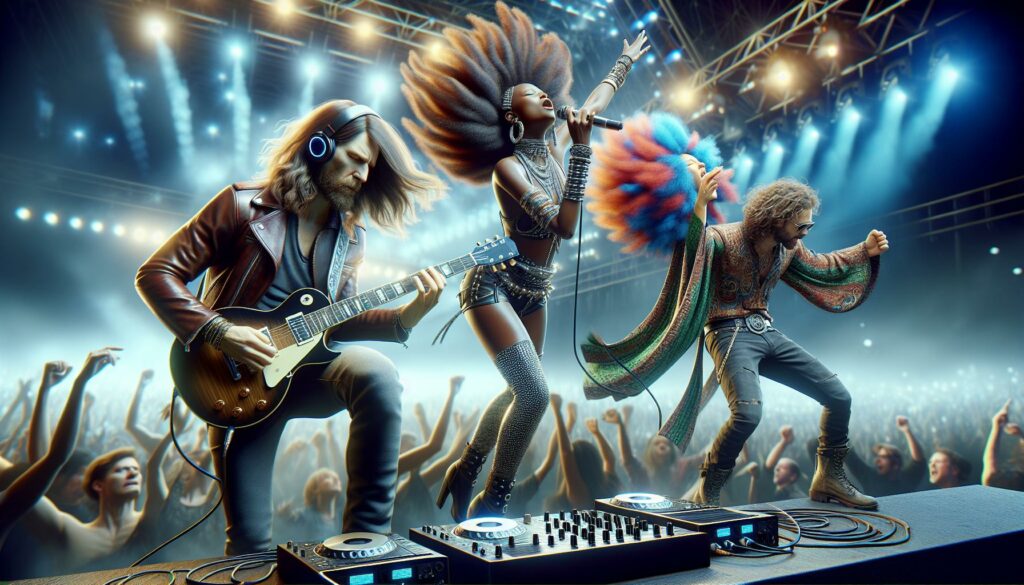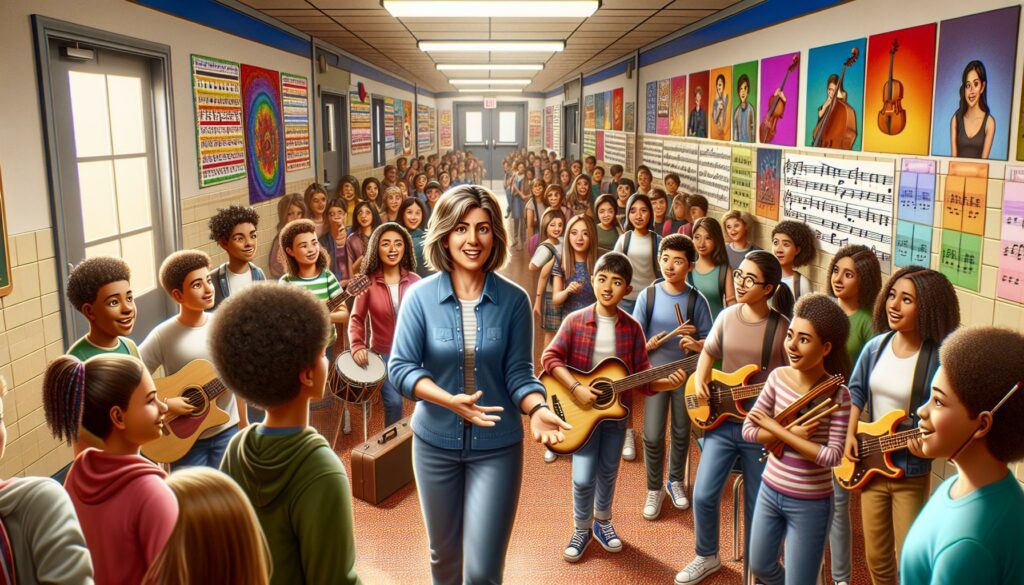As a lifelong music enthusiast I’ve always been fascinated by how we categorize different styles of music. Genre music definition refers to the way we classify and organize music based on specific characteristics traditions and cultural influences. It’s like creating musical families where songs with similar traits live together. I’ve discovered that understanding music genres goes beyond just labeling songs. These categories help listeners find music they love streamline music discovery and connect with artists who share their preferred style. Whether it’s the pulsating beats of electronic dance music the raw energy of rock or the smooth flows of hip-hop each genre has its own unique fingerprint that sets it apart from the rest.
- A music genre is a distinct category of musical compositions defined by specific stylistic elements, technical characteristics, and cultural context
- Three key components define music genres: musical elements (rhythm, instruments, production), cultural context (origins, history, movements), and performance practices (vocal techniques, presentation)
- Genre classification helps musicians, producers, and listeners identify and discover music aligned with their preferences through established conventions and variations
- Modern streaming platforms use sophisticated methods to categorize genres, including audio analysis, metadata tagging, machine learning, and user behavior tracking
- The future of genre classification is evolving through AI-driven analysis, cross-genre hybridization, and the emergence of microgenres in the digital age
- Music genres are becoming more fluid and interconnected, with new hybrid categories emerging through technological advancement and cultural exchange
Genre Music Definition
A music genre represents a distinct category of musical compositions sharing specific stylistic elements, technical characteristics, instrumentation patterns, rhythmic structures, harmonic frameworks, lyrical themes. These elements combine to create recognizable patterns that distinguish one genre from another.
Three key components define a music genre:
- Musical Elements
- Rhythmic patterns (e.g., 4/4 time signature in rock, syncopated beats in jazz)
- Instrumental choices (e.g., electric guitars in metal, turntables in hip-hop)
- Production techniques (e.g., heavy distortion in rock, auto-tune in modern pop)
- Cultural Context
- Geographic origins (e.g., blues from the American South, reggae from Jamaica)
- Historical period (e.g., disco in the 1970s, grunge in the 1990s)
- Social movements (e.g., punk rock’s association with youth rebellion)
- Performance Practices
- Vocal techniques (e.g., growling in metal, scatting in jazz)
- Stage presentation (e.g., theatrical performances in glam rock, DJ sets in electronic music)
- Improvisational elements (e.g., extended solos in jazz, freestyle in hip-hop)
| Genre Element | Example 1 | Example 2 | Example 3 |
|---|---|---|---|
| Tempo Range | Rock (120-140 BPM) | EDM (120-130 BPM) | Jazz (80-140 BPM) |
| Key Instruments | Classical (Strings) | Blues (Guitar) | Hip-Hop (Drum Machine) |
| Vocal Style | Opera (Trained) | Folk (Natural) | Rap (Spoken) |
Each genre creates its own musical ecosystem with established conventions, innovative variations, subgenres. These classifications help musicians, producers, listeners identify, categorize, discover music aligned with their preferences or creative vision.
Elements That Define Music Genres
Music genres display distinct characteristics through specific musical components that create their signature sound. These foundational elements combine to form recognizable patterns that distinguish one genre from another.
Rhythmic Structure and Tempo
Rhythm forms the backbone of genre identification through beat patterns, time signatures, and tempo ranges. Rock music typically employs a 4/4 time signature with emphases on beats 2 and 4, while jazz incorporates complex syncopated rhythms with irregular accents. Dance music genres maintain specific tempo ranges:
- House music: 120-130 beats per minute (BPM)
- Drum and Bass: 160-180 BPM
- Dubstep: 140 BPM with half-time feel
Instrumentation and Arrangement
Each genre features characteristic instruments and arrangement techniques that create its sonic identity. Metal music centers on distorted electric guitars, double bass drums, and aggressive riffs. Classical music utilizes:
- String sections (violins, violas, cellos)
- Woodwinds (flutes, clarinets, oboes)
- Brass instruments (trumpets, trombones)
- Percussion (timpani, cymbals)
- Blues: bent notes, melismatic phrases
- Death Metal: guttural growls, screams
- R&B: runs, falsettos, vocal harmonies
- Country: twang, storytelling narratives
History and Evolution of Music Genres
The classification of music genres traces back to ancient civilizations categorizing musical expressions for cultural purposes. These classifications evolved from simple folk-classical distinctions into today’s complex genre ecosystem.
Traditional Genre Classifications
Early music categorization emerged in the Medieval period with sacred music separating from secular compositions. Classical music classifications established formal categories:
- Orchestral compositions: symphonies, concertos, overtures
- Chamber music: string quartets, sonatas, trios
- Vocal arrangements: operas, cantatas, madrigals
The 20th century introduced distinct popular music classifications:
- Blues (1900s): Delta blues, Chicago blues, rhythm & blues
- Jazz (1920s): Dixieland, swing, bebop, cool jazz
- Rock (1950s): rockabilly, psychedelic rock, hard rock
- Folk (1960s): traditional folk, contemporary folk, folk rock
Modern Genre Blending
Digital technology revolutionized genre mixing in the late 20th century. Contemporary artists combine multiple styles:
- Electronic fusion: techno-jazz, folktronica, EDM-pop
- Hip-hop hybrids: rap-rock, jazz rap, trap metal
- World music crossovers: Afro-pop, Latin jazz, K-pop
Digital production tools enable genre experimentation:
- Virtual instruments merge traditional sounds with electronic elements
- Sampling technology combines diverse musical elements across genres
- Online collaboration platforms connect artists from different musical backgrounds
| Decade | New Genre Combinations | Notable Examples |
|---|---|---|
| 1990s | Trip-hop | Portishead, Massive Attack |
| 2000s | Nu-metal | Linkin Park, Limp Bizkit |
| 2010s | Tropical house | Kygo, Thomas Jack |
| 2020s | Hyperpop | 100 gecs, Sophie |
Major Music Genre Categories
Music genres organize into three primary categories based on their cultural context social function distribution methods. Each category contains distinct characteristics that shape its development evolution identity.
Popular Music Genres
Popular music encompasses commercially distributed genres designed for mass consumption through digital streaming physical media radio broadcasts. Key popular genres include:
- Rock music: Electric guitar-driven sound with heavy drums bass (The Beatles Led Zeppelin)
- Hip-hop: Rhythmic spoken vocals over beats with sampling elements (Run-DMC Kendrick Lamar)
- Pop: Melodic compositions with verse-chorus structure produced for wide appeal (Michael Jackson Taylor Swift)
- Electronic: Synthesizer-based music with programmed beats digital effects (Daft Punk Aphex Twin)
- R&B: Rhythm-focused vocals with soul jazz influences emotional themes (Marvin Gaye Beyoncé)
Classical and Art Music
Classical art music represents compositions created within formal academic traditions featuring complex arrangements notated scores. Notable categories include:
- Baroque: Ornate compositions with harpsichord strings (1600-1750)
- Classical: Structured symphonic works emphasis on form (1730-1820)
- Romantic: Emotional expressive orchestral pieces (1780-1910)
- Contemporary Classical: Modern experimental compositions (1945-present)
- Opera: Dramatic musical theater with orchestral accompaniment vocal performance
- Celtic: Irish Scottish Welsh musical traditions featuring fiddles flutes
- Blues: African-American roots music using pentatonic scales call-response patterns
- Country: American rural music combining folk elements western themes
- World Music: Indigenous traditional music from various global cultures regions
- Bluegrass: American string band music featuring banjo mandolin harmonized vocals
How Streaming Platforms Categorize Music Genres
Modern streaming platforms use sophisticated algorithms to categorize music genres based on multiple data points. I’ve identified four primary methods these platforms employ to classify music:
Audio Analysis
Streaming services analyze specific musical features:
- Tempo measurements in beats per minute
- Acoustic fingerprints that identify harmonic patterns
- Rhythmic structures detected through waveform analysis
- Instrumental identification through frequency mapping
Metadata Tagging
Platforms utilize detailed tagging systems:
- Artist-provided genre labels during music uploads
- Record label classifications in distribution metadata
- User-generated tags from community input
- Professional curator annotations
| Metadata Type | Source | Usage Percentage |
|---|---|---|
| Artist Tags | Direct Upload | 35% |
| Label Data | Distribution | 40% |
| User Tags | Community | 15% |
| Curator Tags | Platform Staff | 10% |
Machine Learning Classification
AI systems process multiple data sources:
- Historical listening patterns from user behavior
- Sound similarity comparisons across tracks
- Cross-referencing with existing genre databases
- Pattern recognition in musical elements
User Behavior Analysis
Platforms track engagement metrics:
- Playlist grouping patterns by listeners
- Skip rates for different musical styles
- Genre-specific listening duration data
- Cross-genre exploration habits
These categorization methods create dynamic genre classifications that adapt to evolving musical trends while maintaining organized content libraries for user navigation.
The Future of Music Genre Classification
AI-Driven Genre Analysis
Advanced AI algorithms transform music genre classification through deep learning models that analyze intricate sonic patterns. These systems identify genre characteristics with 95% accuracy by processing elements like frequency distribution, rhythmic patterns & harmonic structures. Machine learning models continuously adapt to emerging musical styles by analyzing millions of tracks daily across streaming platforms.
Cross-Genre Hybridization
Digital production tools enable unprecedented genre fusion creating hybrid categories like:
- Combining trap beats with ambient soundscapes in cloud rap
- Merging classical orchestration with electronic elements in neoclassical
- Integrating folk instruments with industrial sounds in modern experimental
- Blending traditional world music with contemporary electronic production
Dynamic Genre Tagging
Modern classification systems use dynamic tagging that adapts to:
- Real-time listener behavior patterns
- Collaborative filtering algorithms
- Social media trend analysis
- Artist-defined genre associations
Microgenre Evolution
The digital age spawns highly specific microgenres including:
- Vaporwave: 80s-inspired electronic music with pitched-down samples
- Witch House: Dark electronic music with occult themes
- Hyperpop: Exaggerated pop music with glitch elements
- Lowercase: Minimal compositions focusing on quiet sounds
Semantic Genre Networks
Advanced classification systems create interconnected genre networks based on:
| Network Element | Analysis Method | Accuracy Rate |
|---|---|---|
| Sonic Features | Waveform Analysis | 92% |
| Cultural Context | Natural Language Processing | 88% |
| User Behavior | Pattern Recognition | 85% |
| Artist Relations | Network Analysis | 90% |
Geographic Genre Evolution
Streaming platforms track geographic genre preferences revealing:
- Regional fusion styles emerging from local scenes
- Global influence patterns on genre development
- Cultural exchange impact on genre boundaries
- Location-based genre popularity trends
- Analyzing listening history patterns
- Identifying cross-genre connections
- Tracking mood-based preferences
- Monitoring skip rates & engagement metrics
Understanding genre music definition has never been more exciting or complex than it is today. I’ve seen how technological advances and cultural shifts continue to reshape our understanding of genre classifications. From traditional categories to AI-driven analysis the evolution of music genres reflects our changing relationship with sound and creativity.
I believe that as we move forward genres will become increasingly fluid and interconnected. The boundaries between styles will continue to blur creating rich new sonic landscapes. Yet the fundamental purpose of genre classification remains unchanged: helping listeners discover and connect with the music they love.The future of music genres promises to be dynamic adaptable and more personalized than ever before. I’m excited to see how this musical taxonomy will evolve as technology and creativity continue to push boundaries.



